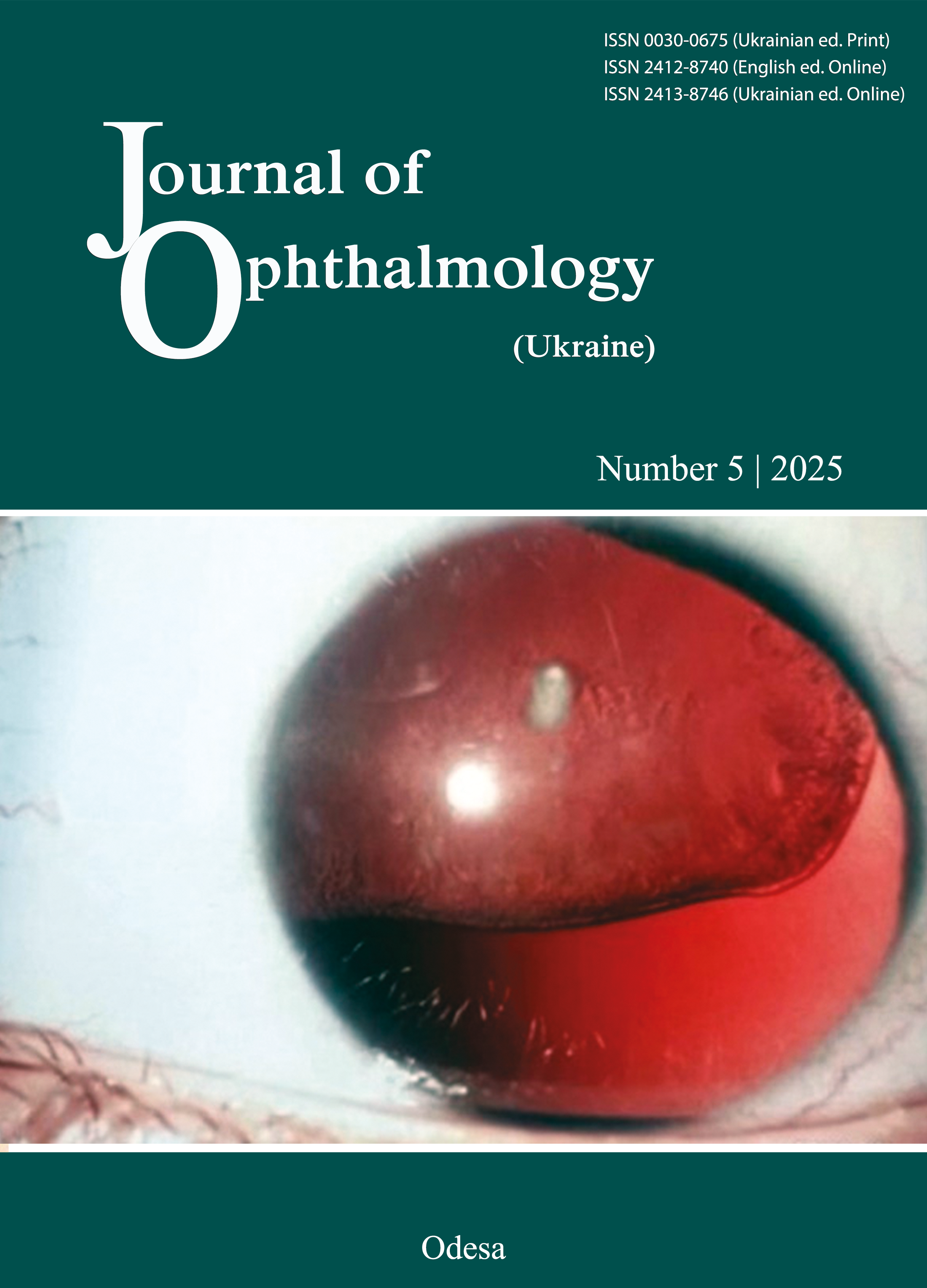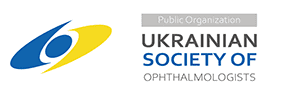Risk of visual impairment in patients with neovascular glaucoma and synechial closures of the iridocorneal corner after double transscleral cyclophotocoagulation
DOI:
https://doi.org/10.31288/oftalmolzh202551927Keywords:
diabetes mellitus, retinal vein occlusion, neovascular glaucoma, iridocorneal angle, cyclophotocoagulationAbstract
Purpose: To assess the risk of worsening of visual function at 12 months after diode transscleral cyclophotocoagulation (TSCPC) for neovascular glaucoma (NVG) secondary to diabetic retinopathy (DR) or retinal vein occlusion (RVO) performed at various durations of synechial angle closure.
Material and Methods: Two hundred and nine patients (209 eyes) with NVG secondary to DR or RVO were included in the study. In all patients, NVG was accompanied by active neovascularization, and patients varied in the duration of angle closure at the initiation of TSCPC. Median (interquartile (IQR) range) intraocular pressure (IOP) and best-corrected visual acuity (BCVA) at baseline were 36.0 (33; 40) and 0.03 (0.02; 0.06), respectively. Of 209 patients, 38% had prior panretinal photocoagulation (PRP) and antiangiogenic therapy. All patients had a modified diode TSCPC. Treatment success was assessed at 12 months and was defined as an IOP equal to or below 21 mmHg, an improvement in or preservation of preoperative BCVA, and a reduction in or stabilization of preoperative phosphene threshold current (PTC), in the absence of eye pain.
Results: At 12 months, 146 (70%) of patients showed no change or an improvement in median BCVA (IQR) to 0.06 (0.03; 0.1) (p < 0.001), and regression of angle and iris neovascularization. Of these, 69 (47%) had prior PRP and antiangiogenic therapy. Cox regression analysis showed that, in patients having no prior PRP or anti-VEGF therapy, the median hazard ratio (95% confidence interval) of a reduction in BCVA at 12 months was 1.1 (0.7; 1.73) for the 6 week duration of angle closure at the initiation of TSCPC, and 4.6 (2.8; 7.7) for the 14 week duration of angle closure at the initiation of TSCPC versus 1.09 (0.6; 1.97) for patients having prior PRP or anti-VEGF therapy.
Conclusion: In patients with NVG secondary to DR or RVO and active neovascularization and angle closure, early (≤ 6 weeks after an attack of angle closure) diode TSCPC and prior PRP and anti-VEGF therapy enable a significant reduction in the hazard of worsening of BCVA at 12 months.
References
Călugăru D, Călugăru M. Etiology, pathogenesis, and diagnosis of neovascular glaucoma. Int J Ophthalmol. 2022 Jun 18;15(6):1005-1010. https://doi.org/10.18240/ijo.2022.06.20
Barac IR, Pop MD, Gheorghe AI, Taban C. Neovascular secondary glaucoma, etiology and pathogenesis. Rom J Ophthalmol. 2015; 59(1): 24-28.
Mannina A, Olivier M, Patrianakos T. Neovascular glaucoma. Dis Mon. 2021 May;67(5):101137.https://doi.org/10.1016/j.disamonth.2021.101137
Shchomak Z, Cordeiro Sousa D, Leal I, Abegão Pinto L. Surgical treatment of neovascular glaucoma: a systematic review and meta-analysis. Graefes Arch Clin Exp Ophthalmol. 2019 Jun;257(6):1079-1089.https://doi.org/10.1007/s00417-019-04256-8
Lin H, Gao X, Wu Z, Tam W, Huang, W, Dong Y.et al. Treatment modalities and trends for hospitalized patients with neovascular glaucoma: A retrospective study of 10 years. Asia Pac J Ophthalmol (Phila). 2025 Jan-Feb;14(1):100136. https://doi.org/10.1016/j.apjo.2025.100136
Urbonavičiūtė D, Buteikienė D, Janulevičienė I. A Review of Neovascular Glaucoma: Etiology, Pathogenesis, Diagnosis, and Treatment. Medicina (Kaunas, Lithuania). 2022; 58(12): 1870. https://doi.org/10.3390/medicina58121870
Bowden EC, Choudhury A, Gedde SJ, Feuer WJ, Christakis PG, Savatovsky E, et al. Risk Factors for Failure of Tube Shunt Surgery: A Pooled Data Analysis. Am J Ophthalm. 2022; 240: 217-224. https://doi.org/10.1016/j.ajo.2022.02.027
Kang YK, Shin JP, Kim DW. Long-term surgical outcomes of Ahmed valve implantation in refractory glaucoma according to the type of glaucoma. BMC ophthalmology. 2022; 22(1): 270. https://doi.org/10.1186/s12886-022-02493-w
Netland PA, Ishida K, Boyle JW. The Ahmed Glaucoma Valve in patients with and without neovascular glaucoma. J Glaucoma. 2010; 19(9): 581-586.https://doi.org/10.1097/IJG.0b013e3181ca7f7f
Wakabayashi T, Oshima Y, Sakaguchi H, Ikuno Y, Miki A, Gomi F, et al. Intravitreal bevacizumab to treat iris neovascularization and neovascular glaucoma secondary to ischemic retinal diseases in 41 consecutive cases. Ophthalmology. 2008; 115(9): 1571-1580.e15803. https://doi.org/10.1016/j.ophtha.2008.02.026
Yang H, Yu X, Sun X. Neovascular glaucoma: Handling in the future. Taiwan J Ophthalmol. 2018; 8(2): 60-66. https://doi.org/10.4103/tjo.tjo_39_18
Asif H, Si Z, Quan S, Amin P, Dao D, Shaw L, et al. Neovascular Glaucoma from Ocular Ischemic Syndrome Treated with Serial Monthly Intravitreal Bevacizumab and Panretinal Photocoagulation: A Case Report. Case Rep Ophthalmol Med. 2022 Jul 28:2022:4959522.https://doi.org/10.1155/2022/4959522
Rittiphairoj T, Roberti, G, Michelessi, M. Anti-vascular endothelial growth factor for neovascular glaucoma. Cochrane Database Syst Rev. 2023; 4(4): CD007920. https://doi.org/10.1002/14651858.CD007920.pub4
Dastiridou AI, Katsanos A, Denis P, Francis BA, Mikropoulos DG, Teus MА, et al. Cyclodestructive Procedures in Glaucoma: A Review of Current and Emerging Options. Adv Ther. 2018; 35(12): 2103-2127. https://doi.org/10.1007/s12325-018-0837-3
Lee JS, Lee YB, Kim TW, Park KH. Visual prognosis and surgical timing of Ahmed glaucoma valve implantation for neovascular glaucoma secondary to diabetic vitrectomy. BMC ophthalmology. 2023; 23(1): 107. https://doi.org/10.1186/s12886-023-02846-z
Wang J, Chun LY, Qiu M. Cyclophotocoagulation in Neovascular Glaucoma with Near-Total Synechial Angle Closure. Case Rep Ophthalmol Med. 2023 Oct 26:2023:5719002. https://doi.org/10.1155/2023/5719002
Guzun OV, Zadorozhnyy OS, Nasinnyk IO, Chargui W, Korol AR. Duration of the hypotensive effect of modified transscleral cyclophotocoagulation in patients with diabetic neovascular glaucoma. J Ophthalmol (Ukraine). 2025; 2: 9-16.https://doi.org/10.31288/oftalmolzh20252916
Guzun O, Zadorozhnyy O, Nasinnyk I, Korol A. Efficacy of modified diode transscleral cyclophotocoagulation in patients with painful neovascular glaucoma secondary to retinal vein occlusion. J Ophthalmol (Ukraine). 2025;3: 3-10.https://doi.org/10.31288/oftalmolzh20253310
Fife D. Flexplot: Graphically-based data analysis. Psychological methods. 2022; 27(4): 477-496.https://doi.org/10.1037/met0000424
Tang Y, Shi Y, Fan Z. The mechanism and therapeutic strategies for neovascular glaucoma secondary to diabetic retinopathy. Frontiers in endocrin. 2023; 14: 1102361. https://doi.org/10.3389/fendo.2023.1102361
Morgan J. Pathogenesis of glaucomatous optic neuropathy. In: Shaarawy TM, Sherwood MB, Crowston JG, Hitchings RA, eds. Glaucoma: Medical Diagnosis & Therapy. Vol. 1. Philadelphia: Saunders-Elsevier; 2009:45-54.
Hayreh SS. Blood flow in the optic nerve head and factors that may influence it. Prog Retin Eye Res. 2002; 20(5): 595-624.https://doi.org/10.1016/S1350-9462(01)00005-2
Hayreh SS. Ischemic optic neuropathy. Prog Retin Eye Res. 2009; 28(1): 34-62. https://doi.org/10.1016/j.preteyeres.2008.11.002
Weinreb RN, Aung T, Medeiros FA. The pathophysiology and treatment of glaucoma: a review. JAMA. 2014; 311(18): 1901-1911.https://doi.org/10.1001/jama.2014.3192
Garcia-Sanchez J, Lin D, Liu WW. Mechanosensitive ion channels in glaucoma pathophysiology. Vis Res. 2024; 223, 108473.https://doi.org/10.1016/j.visres.2024.108473
Alabduljabbar K, Bamefleh DA, Alzaben KA, Al Owaifeer AM, Malik R. Cyclophotocoagulation versus Ahmed Glaucoma Implant in Neovascular Glaucoma with Poor Vision at Presentation. Clin Ophthalmol (Auckland, N.Z.). 2025; 18: 163-171.https://doi.org/10.2147/OPTH.S424321
Zadorozhnyy O, Guzun O, Kustryn T, Nasinnyk I, Chechin P, Korol A. Targeted transscleral laser photocoagulation of the ciliary body in patients with neovascular glaucoma. J Ophthalmol (Ukraine). 2019;4:3-7.https://doi.org/10.31288/oftalmolzh2019437
Fong AW, Lee GA, O'Rourke P, Thomas R. Management of neovascular glaucoma with transscleral cyclophotocoagulation with diode laser alone versus combination transscleral cyclophotocoagulation with diode laser and intravitreal bevacizumab. Clin & Exp Ophthalmol. 2011; 39(4): 318-323. https://doi.org/10.1111/j.1442-9071.2010.02449.x
Rotchford AP, Jayasawal R, Madhusudhan S, Ho S, King AJ, Vernon, SA. Transscleral diode laser cycloablation in patients with good vision. Br J Ophthalmol. 2010; 94(9): 1180-1183. https://doi.org/10.1136/bjo.2008.145565
Si Y, Chen Q, Xiong X, Zheng M. The association of inflammatory biomarkers with clinical outcomes in diabetic retinopathy participants: data from NHANES 2009-2018. Diabetol Metab Syndr. 2024; 16(1): 181. https://doi.org/10.1186/s13098-024-01419-4
Sun C, Zhang H, Tang Y, Chen Y, Li Y, Nie C, et al. Aqueous Inflammation and Ischemia-Related Biomarkers in Neovascular Glaucoma with Stable Iris Neovascularization. Current Eye Res. 2025; 45(12): 1504-1513. https://doi.org/10.1080/02713683.2020.1762226
Sun C, Zhang H, Jiang J, Li Y, Nie C, Gu J, et al.Angiogenic and inflammatory biomarker levels in aqueous humor and vitreous of neovascular glaucoma and proliferative diabetic retinopathy. Intern Ophthalm. 2020; 40(2): 467-475. https://doi.org/10.1007/s10792-019-01207-4
Guzun OV, Zadorozhnyy OS, Vychuzhanin VV, Khramenko NI, Velichko LM, Korol AR. Et al. A neural network model for predicting the effectiveness of treatment in patients with neovascular glaucoma associated with diabetes mellitus. Rom J Ophthalm. 2024; 68(3): 294-300. https://doi.org/10.22336/rjo.2024.53
Hwang YH, Lee S, Kim M, Choi J. Comparison of treatment outcomes between slow coagulation transscleral cyclophotocoagulation and micropulse transscleral laser treatment. Sci Rep. 2024; 14(1): 23944. https://doi.org/10.1038/s41598-024-75246-y
Hong, Y, Hu Y, Dou H, Wang C, Zhang C, Ma Z. Comparison of the safety and efficacy of triple sequential therapy and transscleral cyclophotocoagulation for neovascular glaucoma in the angle-closure stage. Sci Rep. 2018; 8(1): 7074. https://doi.org/10.1038/s41598-018-25394-9
La Rosa LR, Pepe V, Lazzara F, Romano GL, Conti F, Giuffrida E, et al. Retinal Protection of New Nutraceutical Formulation. Pharmaceutics. 2025; 17(1): 73. https://doi.org/10.3390/pharmaceutics17010073
Downloads
Published
How to Cite
Issue
Section
License
Copyright (c) 2025 Guzun O.V., Dunaieva L. M., Nasinnyk I.O.

This work is licensed under a Creative Commons Attribution 4.0 International License.
This work is licensed under a Creative Commons Attribution 4.0 International (CC BY 4.0) that allows users to read, download, copy, distribute, print, search, or link to the full texts of the articles, or use them for any other lawful purpose, without asking prior permission from the publisher or the author as long as they cite the source.
COPYRIGHT NOTICE
Authors who publish in this journal agree to the following terms:
- Authors hold copyright immediately after publication of their works and retain publishing rights without any restrictions.
- The copyright commencement date complies the publication date of the issue, where the article is included in.
DEPOSIT POLICY
- Authors are permitted and encouraged to post their work online (e.g., in institutional repositories or on their website) during the editorial process, as it can lead to productive exchanges, as well as earlier and greater citation of published work.
- Authors are able to enter into separate, additional contractual arrangements for the non-exclusive distribution of the journal's published version of the work with an acknowledgement of its initial publication in this journal.
- Post-print (post-refereeing manuscript version) and publisher's PDF-version self-archiving is allowed.
- Archiving the pre-print (pre-refereeing manuscript version) not allowed.












